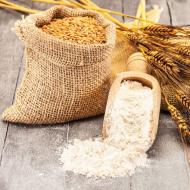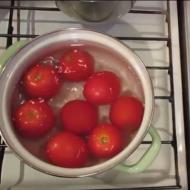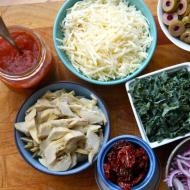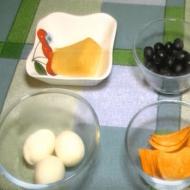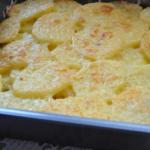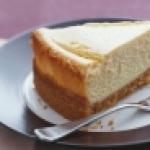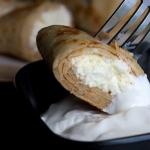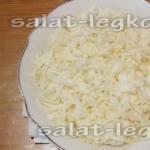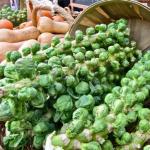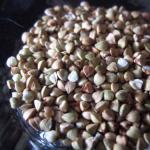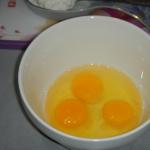
What flour is best for mash? We prepare moonshine from rye and wheat flour. Moonshine recipe using enzymes
Recipes for moonshine made from flour have been known in Rus' since at least the 17th century. And even though the process of obtaining a strong distillate from such raw materials is not simple, its quality and organoleptic characteristics more than pay for the effort expended.
What is the complexity of the recipe for making moonshine from flour at home? The thing is that flour (and the original grain) contains no simple sugars. Therefore, the yeast has nothing to “eat”. But 60-70% of grains are starch, and it is a carbohydrate - a polysaccharide. And it is precisely this that can be broken down into smaller sugar molecules, which the yeast will simply and happily convert into alcohol. The process of this splitting is called saccharification. This is the difficulty: the raw materials for the mash must first be saccharified, then the mash itself must be supplied, and only then the distillate must be distilled out. However, if you follow the instructions for making moonshine from flour, you will definitely end up with a very, very worthy drink.
How to saccharify flour? There are two options: malt or enzymes A and D (amylosubtilin and glucavamorin). Below we will look at recipes for moonshine made from different flours using both malt and enzymes. What is malt? These are sprouted grains of cereals. Why is it used for saccharification? The starch in grains is a store of nutrients. In order for a plant to grow from a grain, a complex chain of chemical transformations is launched in the sprouted grain, including the release of enzymes that break down starch into sugars necessary for the nutrition and growth of the grain. It is these natural enzymes that will simultaneously convert flour starch into a nutrient medium for yeast.
Enzymes A and D are laboratory-produced, purified complex molecules that have the same task: to break down starch into sugars. They are more difficult to obtain than malt (which you can prepare yourself if you wish), but they perform the saccharification function properly.
We put mash for the rye flour moonshine recipe
Rye is the raw material used to prepare world-famous Scotch whiskey. For the purity of organoleptic characteristics, we will use rye flour and rye malt, although, in principle, you can use any malt.
Ingredients for mash:
- rye flour - 2 kilograms
- rye malt - 500 grams
- clean water - 10 liters
- dry yeast - 15 grams
Making mash:
Important. To prevent the “porridge” (mash) of flour from burning, it is best to carry out the entire sequence of actions for saccharification of flour in a water bath. You will also need a thermometer for this work.
- Heat 8 liters of water in a water bath to 50°C and, with constant stirring, add flour in small portions so that the mash is smooth, without lumps.
- Heat the mash at the same temperature for 15 minutes, then increase the temperature of the mash by 10 degrees (up to 60°C) and hold it again for 15 minutes.
- Then bring the mash to a boil and cook for half an hour, stirring occasionally.
- Afterwards, remove the mash from the stove and cool to a temperature of 60°C. While the mash is cooling, grind the malt in a meat grinder or blender to the size of cereal, place it in a fermentation container and fill with the remaining 2 liters of warm (30-32°C) water.
- As soon as the mash has cooled to a temperature of 60°C, combine it with malt, wrap the container in a blanket and put it in a warm place for 4-5 hours to saccharify the starch.
- Then activate the yeast according to the instructions and add it to the fermentation container. Close the lid and install the water seal.
- In a warm, dark place, the fermentation process takes an average of 5 to 10 days.
- The finished mash is clarified in the cold for 24 hours, then removed from the sediment and distilled.
Distillation of rye mash. Getting moonshine.
To be confident in the properties of the resulting product, we recommend (we recommend choosing a device with a distillation column brand) that meets modern quality standards. A homemade unit cannot guarantee the purity of the distillate and its organoleptic properties. The Internet is full of different brands, all you have to do is choose the one that suits you completely.
Mash made from rye flour (as well as mash prepared with enzymes or from corn flour - recipes below) is first distilled at maximum heat without separation into fractions to obtain raw alcohol. Then the raw material is diluted with water to a strength of 20 degrees and re-distilled with fractional division into heads, body, tails. The resulting moonshine is brought to an acceptable strength with water and allowed to rest for 2-3 days in a cool place, after which the amazing drink is ready for consumption both in its pure form and for use in.
Recipes for mash for moonshine made from flour with enzymes
Ingredients:
- any flour - 4 kilograms
- clean water - 16 liters
- enzymes A and D - 10 grams each
- dry yeast - 20 grams
Making mash:
- Bring the water to a boil, add flour in small portions while constantly stirring and turn off the heat.
- When the mash has cooled to a temperature of 80°C, add enzyme A and stir thoroughly.
- At a mash temperature of 65°C, add enzyme G and stir thoroughly.
- Cover the pan with a lid and leave for 3-4 hours to saccharify the starch.
- Then pour the room temperature mash into a fermentation container, add activated yeast, close the lid, install a water seal and put the container in a warm, dark place.
- Approximate fermentation time is 7-10 days.
Distillation of mash is carried out in the same way as described in the recipe for rye flour (see above)
We put mash for the recipe for moonshine made from corn flour. The result will be almost American bourbon!
Ingredients:
- corn flour - 2 kilograms
- clean water - 10 liters
- malt (any) - 500 grams
- granulated sugar - 3 kilograms
- dry yeast - 10 grams
Making mash:
- Saccharify the flour in the same way as the rye flour mash recipe (see above). Only the finished mash, mixed with malt, stand for 12 hours (for rye flour 4-5 hours)
- Pour the sugared mash into a fermentation container, add sugar and activated yeast, mix everything well, close the lid with a water seal and put it in a warm, dark room for 5-7 days.
- Distill the finished mash.
Alcohol can be obtained not only from sugar. Gives a good way out starch, which is found in many products: potatoes, grains, etc. But yeast cannot simply process starch, so first of all it is needed. That is why we are considering two recipes for making flour mash: one with enzymes, and the second with the addition of malt.
Which recipe should you choose? The use of malt is considered more natural and correct. This method is more complex, but with the right technology the result is amazing. If you prefer a simpler recipe, then pay attention to the second method of saccharification using enzymes A and D.

The type and grinding of flour is not fundamentally important for fermentation.
Recipe with proportions
For cooking 25 liters of mash we need:

An example of rye malt from a store.
- Flour - 4 kg.
- Malt - 1 kg.
- Water - 20 liters.
- Alcoholic yeast - 25 grams.
The quality of flour is not of fundamental importance.
It is better to buy malt in a specialized store. It is sometimes sold already ground, looking like coarse flour.
Any mash using starch involves some steps that need to be taken to convert this raw material into sugar. You need as much as possible follow the instructions below and comply temperature regime, since further fermentation greatly depends on it.

Try not to rush while mixing the flour and water.
- Bring 20 liters of water to a boil.
- Gradually add flour to the liquid, vigorously stirring the porridge with a mixer for a screwdriver or drill. It is necessary to dissolve as much as possible the lumps that form during mixing. You can't do this with an ordinary ladle.
- Cook the porridge for about an hour, then gradually cool the mixture to 63 degrees.
- At this time, grind the malt in a blender or meat grinder, it is necessary to grind it as much as possible. Add malt to the wort at a temperature of 60 to 65 degrees.
- Now you need to quickly cool the wort to avoid contamination. The container with mash should be placed in a cold bath and the temperature should be brought to 30 degrees.
- Rehydrate and activate the yeast in a glass of water with two tablespoons of sugar, then add to the fermentation vessel when the temperature of the wort drops to 30 degrees.
- Install a water seal and take the container to a dark place, maintaining the temperature at 23–27 degrees. In about a week the wort will ripen.
- When the release of carbon dioxide bubbles stops, the mash will need to be removed from the sediment, filtered and poured into a distillation cube.
- Carry out two distillations. The first will be simple and fast (until the strength in the stream drops to 30 degrees), and the second will highlight the “head”, “body” and “tails” fractions.
The temperature is maintained in order to properly prepare the flour for fermentation and avoid contamination of the wort.
Any starch-based mash is subject to rapid souring, so carefully monitor the hygiene of equipment and raw materials.
One of my favorite videos from Antonich and Alexey Podolyak. A very serious experience from an experienced moonshiner who will tell you in detail what and how to do in order to get a decent mash from flour and malt.
Mash made from flour and enzymes
Recipe and proportions
Instead of malt, we now add enzymes. For 20 liters of mash we need:

Enzymes A and G.
- Flour - 4 kg.
- Water - 16 liters.
- Enzyme A - 12 grams.
- Enzyme G - 12 grams.
- Alcoholic yeast - 20 grams.
You can purchase enzymes at a specialty store. A couple of small bags will be enough for you to make a dozen batches of mash.
Preparing mash and distilling into moonshine
If in the first case the saccharification of starch is achieved by malt, then in this case we use enzymes A and D(amylosubtilin and glucavamorin). They need to be added at a strictly defined time, so pay close attention to the technology.

Consistency of wort after adding flour.
- Boil water, add flour, cook for an hour, after which we begin to gradually cool the porridge.
- We add enzyme A when the wort has cooled to 80 degrees.
- We add enzyme G when the wort temperature is 65 degrees.
- Add activated yeast at a temperature of 30 degrees.
- We install a water seal and take the fermentation tank to a dark place. We maintain the temperature within 23–27 degrees for one week.
- We remove the ripened mash from the sediment and filter it, after which we send it for distillation.
- The first distillation is fast, and the second involves the separation of three fractions: “head”, “body” and “tails”.
Making mash with enzymes is almost the same as making malt. The temperature conditions are similar, since the malt has its own enzymes inside that work precisely in such conditions.
Let me note once again that need to maintain cleanliness 5+. Sugar mash is quite difficult to spoil, but this one is easy.
For clarity, we recommend watching the video on Youtube from Dobrovara. The author prepares flour mash using enzymes, after which he distills moonshine from it. The recipe is shown in great detail, so everything should be clear to you.
Experienced moonshiners have many recipes for making homemade alcohol, but it never hurts to replenish your knowledge base.
Let's look at how to make moonshine from rye and wheat flour, and how to do it according to the rules. Although the methods are more time-consuming and effort-consuming, this homemade alcohol can be compared to grain in taste.
Most often used for making mash wheat flour. This is explained simply: it contains more starch, and it is also easier to extract. Accordingly, the yield of moonshine is higher. You will get the best results when using the highest grade (baking grade).
But experiments with rye and.
Note. Flour of any grind (1st, 2nd grade) is suitable for making mash. The main thing is that it is not spoiled or moldy.
Depending on the goal - to obtain a cheap and natural product, or an increased amount of moonshine - they use sugar or refuse it.
You will need malt or purchased enzymes A and D (amylosubtilin and glucavamorin). It’s easier to make mash with enzymes. As for malt, we use store-bought or green malt prepared with our own hands.
It is advisable to take softer water: bottled, filtered, spring, or at least settled from the tap.

Recipes for mash made from flour for moonshine
Here are several recipes for making mash. We selected simple and affordable ones at home, and which one is right for you depends on personal preferences.
From rye flour
This recipe calls for the use of malt.
Peculiarities. Malt breaks down starch into simple sugars (saccharifies the wort), and without it (or enzymes) you won't succeed.
You will need:
- 4 kg rye flour;
- 1 kg of dry malt or 1.7-2 kg of green malt;
- 20 liters of water;
- 250 g of raw alcoholic yeast or 25 g of dry yeast.
Barley or rye malt is suitable. The sequence of actions is important because the final result depends on it:
- Boil water (20 liters). Remove from the heat to the floor on a mat and immediately begin to slowly add all the flour according to the recipe, using a stand mixer for high-quality mixing without lumps. This is not easy to do without a mixer.
- Cover the container with a lid and wrap it thoroughly for 2 hours. An old blanket, jackets, etc. will do. During this time, the wort will be thoroughly steamed and infused.
Carefully. Keep track of the time. Keeping it wrapped for a longer period of time can lead to souring.
- Prepare the malt. Grind the dry one with a mixer or a special mill, pass the green one through a meat grinder.
- Measure the temperature of the flour mixture. At 60-65°C, add malt. Wrap the container again. The saccharification process takes place over an hour.
- Do an iodine test. To do this, pour literally a teaspoon of wort onto a white plate and add a couple of drops of iodine. Stir with a cotton swab. Has the color changed to purple? The starch was not completely saccharified. Wrap it up again and let it sit for another half hour. No color changes? Cool the wort immediately, for example in a cold water bath.
Reference. Rapid cooling of the mash is necessary so that foreign microorganisms do not “tackle” it, spoiling the final result.
- When cooled to 25-20°C, add yeast and place the wort under a water seal.
- Fermentation should take place in a warm room.
Made from wheat flour
The wort is prepared according to the same algorithm as from rye. Try making green malt. It is not difficult. Wash high-quality wheat (1.5 kg), add water to just cover, cover with a cloth and leave in a warm room.
After 3 days, when the sprouts appear, grind everything with a meat grinder. Green malt is ready. Instead of wheat, you can use rye or barley.
Flour mash with sugar
You can use barley, wheat, corn or rye flour. Moonshine prepared according to this recipe is a good imitation of bourbon. After distillation, the alcohol must still be infused with oak chips (bark).
Take:
- 23 liters of water;
- 5 kg sugar;
- 5 kg of flour (you can mix different grains);
- 400 ml rye sourdough.
The main thing is to prepare the right starter. Take a glass of water and flour. Stir thoroughly until the mixture is as thick as sour cream. You can add one or the other. Cover with a damp cloth (if dry, moisten!) and leave for a day. Add 50 ml of water and flour to the desired thickness. Repeat for another two to three days. The finished starter should “bubble” and smell like fermentation.
Peculiarities. Leave ¼ of the starter and refrigerate. “Feed” with water and flour once a week. Use not only for mash, but also for.
To make the mash, heat the water to 25-29°C, dissolve the sugar, stirring, add flour, then the starter.
Enzyme brew
Ingredients:
- 1 tbsp each of enzymes A and D;
- 3 kg of premium wheat flour;
- 100 g raw (20 g dry) yeast;
- 12 liters of water.
Mix all ingredients in water at a temperature of 25-29°C and leave to ferment.

Making moonshine with flour
After fermentation is complete, it is important to properly distill the mash in order to obtain high-quality moonshine. Doing so twice as important. The first time - using the direct-flow method, without division into fractions. Then clean the moonshine with coal, milk, soda, etc.
Dilute to 30° and distill again, this time selecting separately the heads -10-15% of the absolute alcohol in the initially obtained alcohol. Drive the body until the strength in the stream drops to 40°. This is precisely the part of moonshine that should be consumed. Next come the tails, which you will add to the mash during the next distillation.
Try, dare and evaluate the result. And tell us about your experiments in the comments to the article.
Making moonshine at home became widespread after the introduction of Prohibition, followed by a significant rise in the price of alcoholic beverages.
Amateur craftsmen distill moonshine for personal use, using a recipe without the use of chemical additives and dyes. When purifying the resulting product from the impurity of fusel oils, various food components are added to enhance the taste of moonshine.
You can make mash from any product that contains sugar or its derivative – starch. Cereals contain starch in the following amounts:
- Rice – up to 86%.
- Wheat - up to 75%.
- Corn - up to 72%.
Less cereal grain is used at home. The preferred recipe is to make mash using flour.
Methods for preparing flour-based moonshine differ in what type of product is used: dry or sprouted.
Sprouting grain
Flour from sprouted grains is called malt, which is necessary to convert starch into sugar so that the resulting mass begins fermentation.
The grain is sprouted by generously moistening it and spreading it under a damp cloth in a 2-3 cm layer. Sprouts that are approximately 4 times the size of the grains serve as a signal for the end of the germination period.
The recipe for making mash for moonshine requires drying and grinding the resulting grain. You should immediately separate ¼ of the flour for malt, which cannot be scalded.
Methods for preparing moonshine with sprouted grains
The recipe for making mash from flour is quite simple:
- For every 1 kg of flour - wheat, barley, rye - take approximately 3.5-4 liters of boiling water.
- The mixture should be vigorously stirred to the consistency of jelly, thoroughly crushing all lumps of flour.
- Cool to 55-60°C.
- Add malt.
The process of converting the starchy mass into a sugary mass lasts about 2 hours, while maintaining a constant temperature of 50-55°C, for which the container should be wrapped in a blanket or something warm. You can check the absence of starch using iodine tincture: by dropping a drop into the liquid, there should be no blue color in the solution. The mixture should be cooled to a temperature of 20-22°C, the most optimal for fermentation.

Then you should add yeast using the recipe: at the rate of 100 grams for every 2.5 kg of flour, from which you can get up to 1 liter of high-quality moonshine.
The fermentation process lasts 3-4 days, increasing the period as the temperature of the liquid drops. The readiness of the mash for distillation is often determined using a burning match, which goes out if the process continues. Before distilling the moonshine, the mash should be strained.
It is good to put a “guard” at the bottom of the vessel for distilling moonshine to prevent milk from running off when boiling. The device saves the mash from burning.
Moonshine prepared according to the recipe using flour has good strength and a mild taste. A hangover eliminates headaches.
Making moonshine from rye flour
- For 20 liters of boiling water you need to add 5 kg of rye flour, no matter what type.
- Mix the mixture with a construction mixer, which is securely fixed in the drill.
- Grind 1 kg of sprouted wheat – the height of the sprouts is about 4 cm – in a blender, dilute with hot water, about 60°C, 4 liters in volume.
- Mix the flour starter with malt, stirring thoroughly with a mixer.
- Leave the container with the mixture, wrapped in something warm to maintain a constant temperature, overnight. It is necessary to stir the solution periodically.
- In the morning, add yeast, 100 grams for every 2.3 kg of rye flour, which will cause vigorous fermentation with the formation of abundant foam. To prevent the mash from “running away”, you should:
- leave room in the container for foam to form;
- sprinkle cookies on top or pour a couple of tablespoons of sunflower oil;
- Stir the solution frequently during intense fermentation.
- After vigorous fermentation, the mash finishes as usual. Duration: 5-9 days.
- When ready, the liquid must be drained and distilled through a moonshine still.

Cleaning the finished drink
You can eliminate the unpleasant smell of moonshine by double distillation or purification: a recipe with activated carbon will help:
- grind the tablets into a powder;
- add to the finished moonshine, calculating the amount of 2 pieces for each liter of moonshine;
- After 1-2 days, the solution should be filtered.
By using the recipe for making mash from flour - rye, wheat, barley and other cereals - you will produce a high-quality alcoholic drink for home consumption.
If you need to clarify some subtleties in the recipe or need a sequence of actions, watch this video:
The process of making moonshine and mash at home has been used for decades. Moonshine was first distilled in the 16th century, when it was called “hot wine.” Everyone has their own homemade moonshine, as well as brewing features, fermentation nuances, and other secrets and wisdom. But the most excellent alcohol is made from grain raw materials.
Making homemade alcohol from flour is a rather labor-intensive process. After all, flour does not contain sugar. For this purpose, a special procedure is used “ saccharification", which is carried out using malt or enzymes. Homemade moonshine lovers say it's worth it. After all, then the alcohol has a pleasant taste, and in addition, in this case it consists of natural ingredients.
Moonshine lovers know many options for how to brew this drink, but the most common is moonshine from rye or wheat flour, using malt or enzymes.
When preparing such moonshine, you should adhere to the following scheme:
- Prepare the malt.
- Introduce yeast for fermentation.
- Boil and saccharify.
- Place the main mash.
Naturally, first we prepare mash for moonshine from flour. The rye flour used as a basis allows the drink to be light and sweet, moderately intoxicating. Moonshine prepared in this way has a pleasant aroma of wheat sprouts. By the way, if you keep such moonshine in an oak barrel, you will get a wonderful whiskey.
To prepare you will need:
- Rye flour – 4 kg.
- Malt – 1 kg.
- Dry yeast – 25 gr.
- Water – 20 l.
We heat the water in a special container - a regular saucepan will do. While stirring, gradually add flour, avoiding the formation of lumps, 15 - 30 minutes. You can use mechanical devices - for small volumes a household mixer, for example, for large volumes - a construction mixer. After the mash boils, leave it on the fire for another 30 minutes, remembering to stir. Then remove from the stove and let cool to 60 degrees.

At the same time, grind the malt into flour using a coffee grinder, blender or meat grinder, mix with warm water and add to the cooled mash (you can use a special fermentation container). Stir and leave to saccharify for 4 - 5 hours.
After a complete saccharification procedure, the mash is cooled to 25 - 28 degrees using a special cooling device (chiller). If this device is not available, you can use a bottle with ice.
Let it ferment for 5-10 days. The mash is ready when the release of gases stops, lightening occurs, or a bitter aftertaste appears. Using a steam generator or steam-water boiler, we will distill the mash.
Moonshine recipe using enzymes
Below is a fairly simple way to make moonshine from flour using enzymes - a truly intoxicating drink. Enzymes are used as malt. The result is a high degree, pleasant aroma and mild taste.
To do this you will need:
- Flour – 4 kg.
- Amylosubtilin (enzyme A) – 10 g.
- Glucavamorin (enzyme G) – 10 g.
- Water – 16 l.
- Dry yeast – 20 gr.
Bring the water to a boil, stirring, add flour to prevent lumps from forming.
When the mixture reaches a temperature of 80C, add enzyme A and stir. Cool to 63C, add enzyme G and stir.
After 2-3 hours, the saccharification process will begin (the wort will become sweet).
Cool the wort to a temperature of 25ºC using a chiller or a bottle with ice.
Option with cornmeal
The drink obtained by this method has a complex taste comparable to bourbon. To prepare this special drink you will need:
- Flour – 4 kg.
- Water – 20 l.
- Sugar – 6 kg.
- Malt – 1 kg.
- Yeast – 20 gr.
- Oak chips.
Bring the water to 50C and gradually add flour. Stir thoroughly to remove all lumps. Let it brew for 15 minutes. Place on fire and heat to 65 degrees. Turn off the heat and let it brew for another 15 minutes. Stir occasionally to ensure the mixture is homogeneous.
Let it cool to a temperature of 65C. Prepare the malt by grinding it in a blender or coffee grinder. Add to the wort, stir and leave to saccharify overnight.
By morning the temperature of the flour mash will reach 30C - at this time we add yeast prepared with the addition of sugar. Let it ferment for 3-7 days. How to determine the readiness of the mash is indicated in the first recipe.
Let's distill. By adding oak chips we will achieve a refined taste and get whiskey.
Driving
When the mash reaches , it should be clarified - put in the cold for a day. Clarification is necessary when the distillation process is carried out on gas or using heating elements. The clarification process can be missed if you distill the mash using a steam generator.
During distillation, raw alcohol leaves without fractions. Braga is driven for the first time to 3-4 degrees. Next, we clean the raw alcohol from the first distillation using coal or potassium permanganate. We fall asleep overnight and the next morning filter through a filter (gauze). We re-distill the raw material and select the head fraction (10% of absolute alcohol). Not suitable for use.
We select the finished fraction up to 70 degrees in the stream. The resulting drink is diluted to the required strength. Let it brew.



